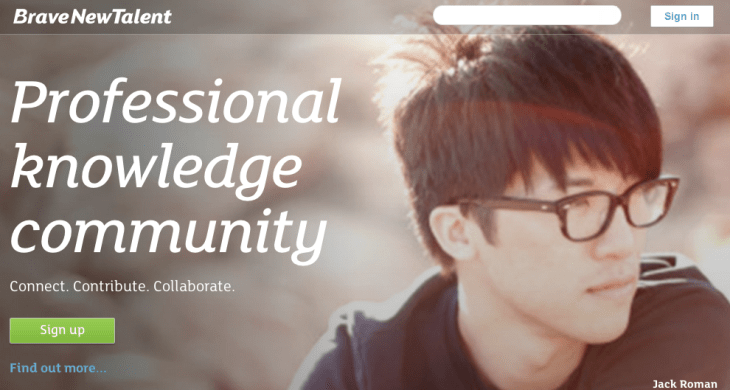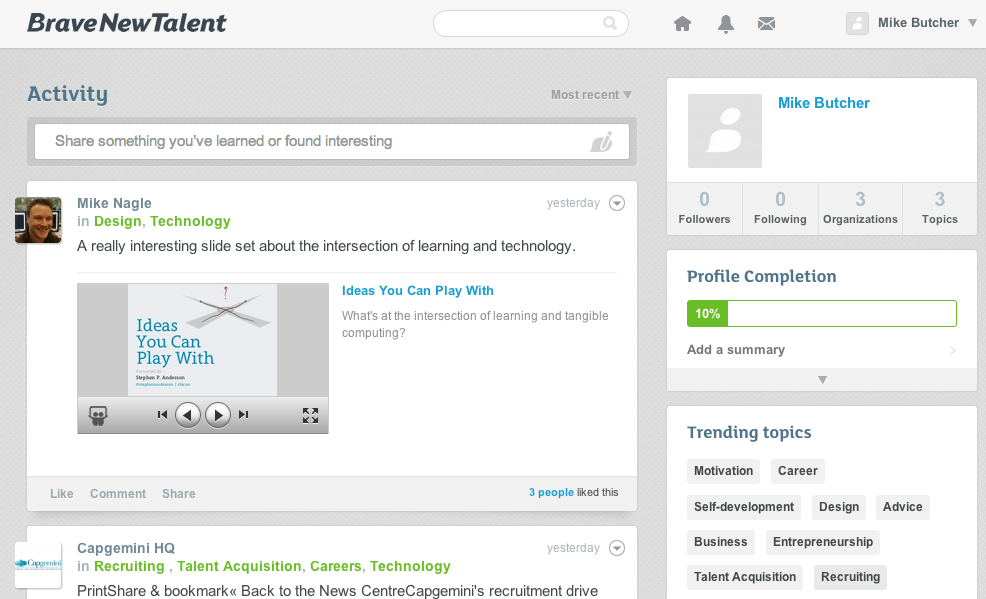BraveNewTalent launched as a ‘social recruitment’ platform back in 2010 and went on to secure VC funding a year later. But last year saw the startup pivot in a big way. The original model was geared towards the idea that people would want to follow companies they might want to work for in the future, and companies in turn wanted to educate potential hires about how they work. If the recruitment process was started earlier earlier – even before positions became available – some of the talent issues would go away. At least that was the theory.
Back in 2011 BraveNewTalent had secured an undisclosed amount of venture capital funding from Northzone Ventures and two angels. Big corporate clients started using the platform, which also integrated with Facebook, just as other ‘recruitment apps’ operated, such as BranchOut, JIBE, Superscout and Emp.ly.
In reality, however, says CEO and founder Lucian Tarnowski, “We realised we were trying to build communities around recruitment content. But trying to build user engagement around transactional content like that doesn’t work. Job seekers just wanted jobs, and recruiters just wanted to fill positions. So the model didn’t scale just focusing on jobs.”
So six months ago BraveNewTalent pivoted towards being 100 percent enterprise focused, and went from ‘social recruiting’ to ‘social learning’.
Is this just semantics or is there now a real difference in what they do?
Well, the new model means companies on the platform can still recruit from an audience of users, but the whole thing is not nearly so ‘job centric’. Instead, says Tarnowski, it is now ‘learning centric’ around the content that is produced – not just by the companies, but by the users themselves.
Perhaps the best way to think of it is if you took Yammer, opened it to anyone to join, then gave them a free hand to post content that was relevant to your industry. Sure it sounds not unlike LinkedIn, but the difference here is that LinkedIn is not used inside the enterprise (like a Yammer). Indeed, BraveNewTalent looks like it is going to end up having a foot in both the free-wheeling Internet and the enterprise communications world.
Looking at the new interface you can see how this might be. The new BraveNewTalent looks reminiscent of how a Yammer might be opened up to be more porous between both internal employees and external users who might one day be called in for an interview.
Of course, it’ll take time. I’ve started following a topic called “Startups“.
But although I’m only the second follower of that topic, that hasn’t prevented there being a lot of content on that topic posted already, since anyone can tag their content with “Startups”. The whole effect is like having a Twitter re-imagined for the enterprise, but with elements of LinkedIn, as if it were built for big-company recruiting.
Tarnowski says he is on-boarding new clients, including eBay, Expedia and RMS (security), alongside Standard Chartered. And this could end up being quite a boon.
Most clients plan to invite past, present and future employees into this single BraveNewTalent community. BraveNewTalent then lets employers filter the users by location, job function, interest levels, etc. For members, they get rewarded and recognised for what they learn and build their scores in topics, which are ‘gamified’ to encourage content creation. A post can be sent to just employees, just Alumni, just LinkedIn, or just to a location, like London.
In fact, the new BraveNewTalent seems to have borrowed not only from LinkedIn and Yammer, but also from Klout. Is it a mashup too far?
No, says Tarnowski. “Companies often say they ‘do talent communities’ but they are basically broadcasting about jobs. And when you implement Yammer, there is no starting point because there is no content. But when you start with BraveNewTalent, you get content from the word go – learning streams curated by the people who follow those streams,” he says. This is not a B2B play but a B2B2C play, he says.
BraveNewTalent is now looking at starting to raise a Series B from Q3, to realise it’s vision further (and they say revenues are “shooting up”) though the company “remains well funded”.
We shall see if this new pivot is the one that gets BraveNewTalent the, err… job.

